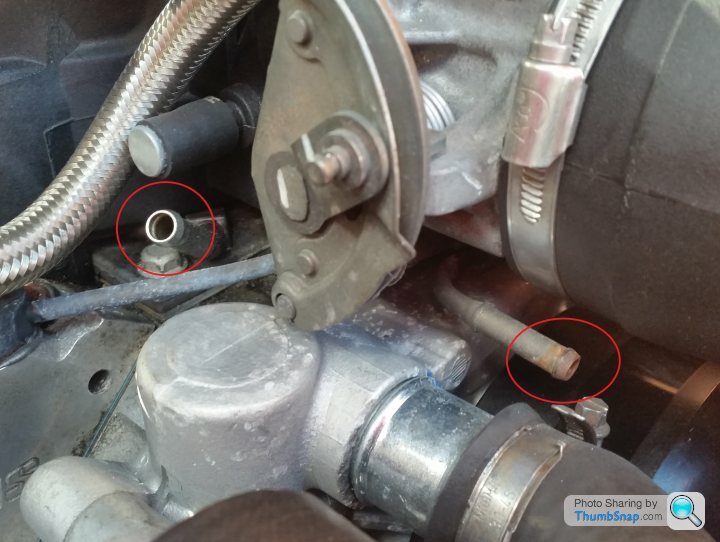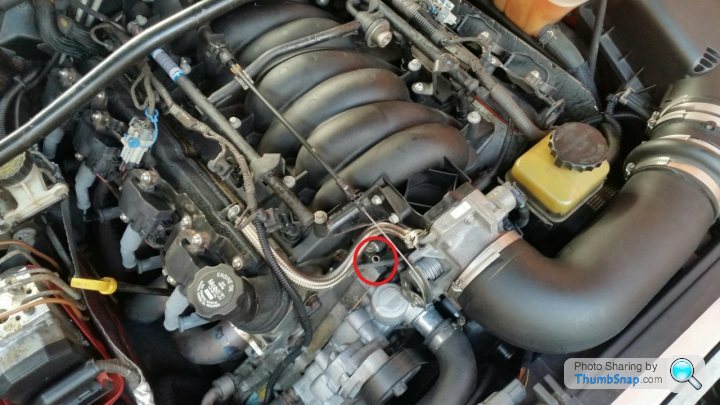5.7 VXR unconnected pipes
Discussion
The one on the left is the PCV Valve coming from the valley cover.
Normally that would have a little u-tube on that goes onto the pipe that's been covered up directly above it (on the intake manifold, behind the throttle body, there's a short piece of black hose with a bolt in the end)
Shouldn't really just be open like that by my understanding.
Crankcase vapour will be coming out of that, so oil mist and air mostly. Do not plumb that into the coolant system.
The one on the right I'm not 100% sure.
Normally that would have a little u-tube on that goes onto the pipe that's been covered up directly above it (on the intake manifold, behind the throttle body, there's a short piece of black hose with a bolt in the end)
Shouldn't really just be open like that by my understanding.
Crankcase vapour will be coming out of that, so oil mist and air mostly. Do not plumb that into the coolant system.
The one on the right I'm not 100% sure.
Thanks. I hadn't noticed much in the way of oil vapour but it would make sense to connect it up. It has Livernois heads if that makes any difference (?)
The pipe on the right may perhaps be an inlet for a water heated throttle body? On my Rover V8 TVRs, the inlet plenum had water pipes in its base that were used in Range Rover applications but left unconnected in a TVR.
The pipe on the right may perhaps be an inlet for a water heated throttle body? On my Rover V8 TVRs, the inlet plenum had water pipes in its base that were used in Range Rover applications but left unconnected in a TVR.
ianwayne said:
Thanks. I hadn't noticed much in the way of oil vapour but it would make sense to connect it up. It has Livernois heads if that makes any difference (?)
The pipe on the right may perhaps be an inlet for a water heated throttle body? On my Rover V8 TVRs, the inlet plenum had water pipes in its base that were used in Range Rover applications but left unconnected in a TVR.
The heads wouldn't make a difference, if it has aftermarket rocker covers then perhaps the OEM PCV system just isn't used. Putting the u-hose back in may well mean some oily vapour is pulled through into the intake manifold. The pipe on the right may perhaps be an inlet for a water heated throttle body? On my Rover V8 TVRs, the inlet plenum had water pipes in its base that were used in Range Rover applications but left unconnected in a TVR.
This is by design, the hose coming off the driver's side rocker cover goes to the big intake elbow to provide fresh air, and under idle / low load that exposed pipe (the left one) is then subjected to vacuum from the intake manifold which pulls crankcase air out through the PCV valve to be burned off and generally vent crankcase pressure.
People often put a catch can into the loop (so valley cover hose to catch can, catch can back to manifold) to catch the oil instead of having it go through the intake manifold, in this instance it's just venting to atmosphere, there's a valve in there that should stop air going back in to the crankcase so it's probably not a big deal, but it's a little unusual if nothing else...
These cars don't have anything fancy coolant wise, I'm struggling to picture what that other pipe could be for, where does the other end of it go? It sort of looks like it goes across the top of the water pump but I can't see what it would be for...
Here's a wider photo, I don't know if they are OEM rocker covers. The passenger side at the bulkhead end has a rubber plug in the vent. The driver's side has a braided pipe coming off it going to the intake elbow.
The throttle body has 'Made in USA' stamped on it so I suspect a larger one than standard has been fitted. It also had a replacement GM water pump fitted a few years ago so the 2nd pipe may be something to do with that as you suggested and not used in this application.
The throttle body has 'Made in USA' stamped on it so I suspect a larger one than standard has been fitted. It also had a replacement GM water pump fitted a few years ago so the 2nd pipe may be something to do with that as you suggested and not used in this application.
ianwayne said:
Here's a wider photo, I don't know if they are OEM rocker covers. The passenger side at the bulkhead end has a rubber plug in the vent. The driver's side has a braided pipe coming off it going to the intake elbow.
The throttle body has 'Made in USA' stamped on it so I suspect a larger one than standard has been fitted. It also had a replacement GM water pump fitted a few years ago so the 2nd pipe may be something to do with that as you suggested and not used in this application.
Can't see the picture, but those sound like factory rockers, the vent on the passenger side points upright correct and has a sort of tapered johnny over it?The throttle body has 'Made in USA' stamped on it so I suspect a larger one than standard has been fitted. It also had a replacement GM water pump fitted a few years ago so the 2nd pipe may be something to do with that as you suggested and not used in this application.
Curious about that second pipe!

Factory rocker covers have the various mounting holes for the coil packs so are fairly distinctive.
Yep, factory covers 
Doesn't help with the mystery second pipe underneath though Would be curious to see where it goes. If it's not too dark/cold I'll have a quick look at the Ute when I get home to see if there's anything similar underneath, that's an LS1, I've spent far more time with my Monaro which is an LS2 so it's possible there's something I've missed (but I can't imagine what it would do...)
Would be curious to see where it goes. If it's not too dark/cold I'll have a quick look at the Ute when I get home to see if there's anything similar underneath, that's an LS1, I've spent far more time with my Monaro which is an LS2 so it's possible there's something I've missed (but I can't imagine what it would do...)
If you wanted some peace of mind you could whack a little filter over the pipe (the PCV one coming off the valley cover) just to make sure nothing falls down into it, they're only a few quid and halfords normally has them on the shelf for convenience.

Doesn't help with the mystery second pipe underneath though
 Would be curious to see where it goes. If it's not too dark/cold I'll have a quick look at the Ute when I get home to see if there's anything similar underneath, that's an LS1, I've spent far more time with my Monaro which is an LS2 so it's possible there's something I've missed (but I can't imagine what it would do...)
Would be curious to see where it goes. If it's not too dark/cold I'll have a quick look at the Ute when I get home to see if there's anything similar underneath, that's an LS1, I've spent far more time with my Monaro which is an LS2 so it's possible there's something I've missed (but I can't imagine what it would do...)If you wanted some peace of mind you could whack a little filter over the pipe (the PCV one coming off the valley cover) just to make sure nothing falls down into it, they're only a few quid and halfords normally has them on the shelf for convenience.
Edited by SturdyHSV on Monday 28th October 16:38
Here is the pipework from my 04 Cv8
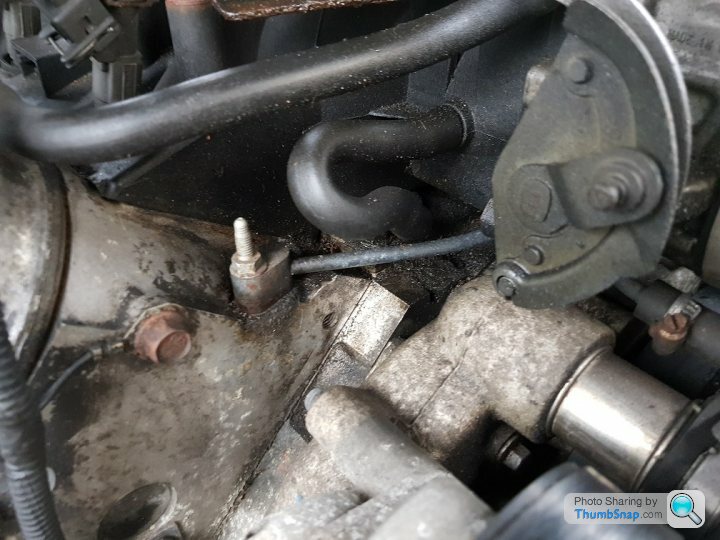
As everyone said, there is supposed to be a u pipe on there as standard.
As for the second lower pipe, this goes to the radiator, as shown below.
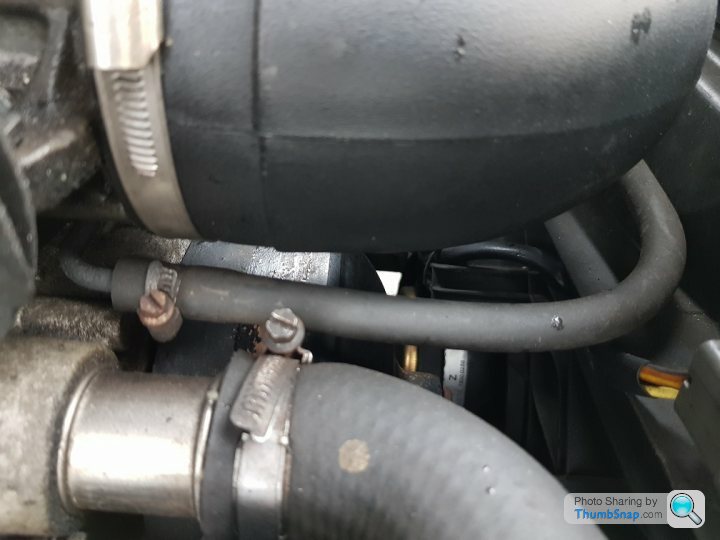
Runs along the front of the air intake.
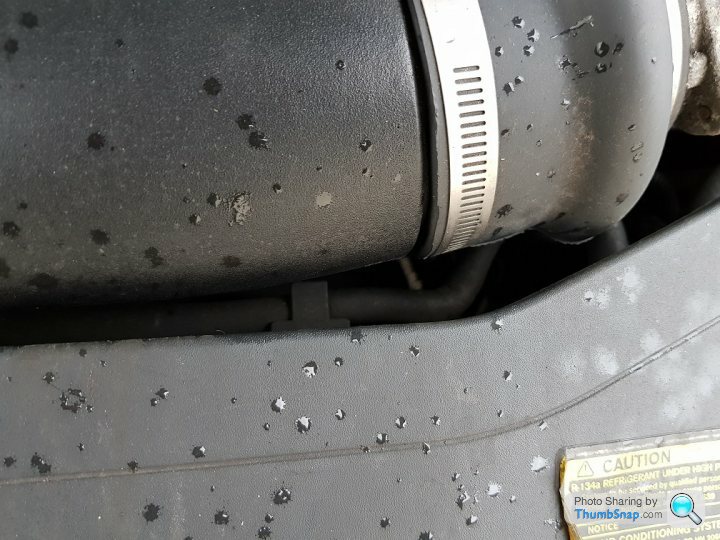
Before attaching to the top of radiaor ( it's the pipe on the right in this photo, the pipe to the left goes to the header tank overflow ).
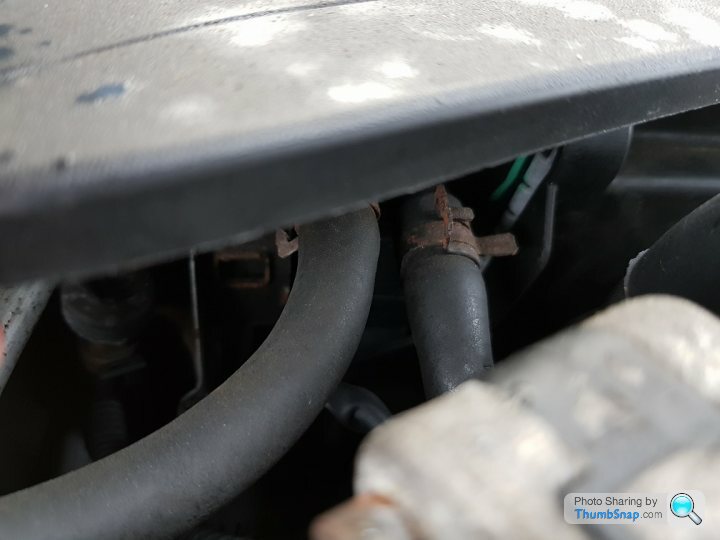
Hope this is a help.

As everyone said, there is supposed to be a u pipe on there as standard.
As for the second lower pipe, this goes to the radiator, as shown below.

Runs along the front of the air intake.

Before attaching to the top of radiaor ( it's the pipe on the right in this photo, the pipe to the left goes to the header tank overflow ).

Hope this is a help.
Edited by MarvinTPA on Wednesday 30th October 09:23
That does help, thanks. My car seems to have had the coolant system plumbed in a bit differently.
It has a replacement Mishimoto radiator but I think the connections are the same. There is another unconnected pipe to the right of and almost under the throttle body that is very similar to the one on the left that I hadn't been aware of before!
So it seems this through metal coolant connection pipe that passes coolant through the throttle body has been bypassed and left unconnected. The rubber hose on the left in your last photo goes into the thin metal pipe that runs between the 2 cylinder heads.
It has a replacement Mishimoto radiator but I think the connections are the same. There is another unconnected pipe to the right of and almost under the throttle body that is very similar to the one on the left that I hadn't been aware of before!
So it seems this through metal coolant connection pipe that passes coolant through the throttle body has been bypassed and left unconnected. The rubber hose on the left in your last photo goes into the thin metal pipe that runs between the 2 cylinder heads.

I seem to recall on my Camaro that it had a heated throttle body which was by-passed to make the intake air colder. There was also an alloy airstream divider that got removed. Anything for a hundredth of a second, in the quarter.
Mind you, that was over 10 years ago so detail is hazy.
Mind you, that was over 10 years ago so detail is hazy.
As I said, the hose connections are there on the radiator, and no coolant comes out of that pipe because none goes in! There are small pipes either side showing there seems to be a waterway going through the throttle body which is now open at both ends.
The point about cold air intake has probably hit the nail on the head. My car has had engine work and it seems that the throttle body coolant pipe has just been ignored!
The point about cold air intake has probably hit the nail on the head. My car has had engine work and it seems that the throttle body coolant pipe has just been ignored!
Here's a few more photos to explain better. I removed the air inlets to get a closer look.There is a small through metal pipe that carries coolant through the base of the throttle body, both ends are unconnected as seen below:
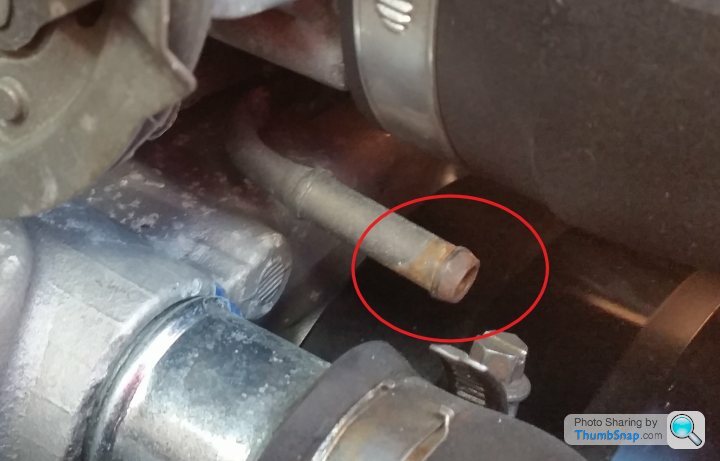
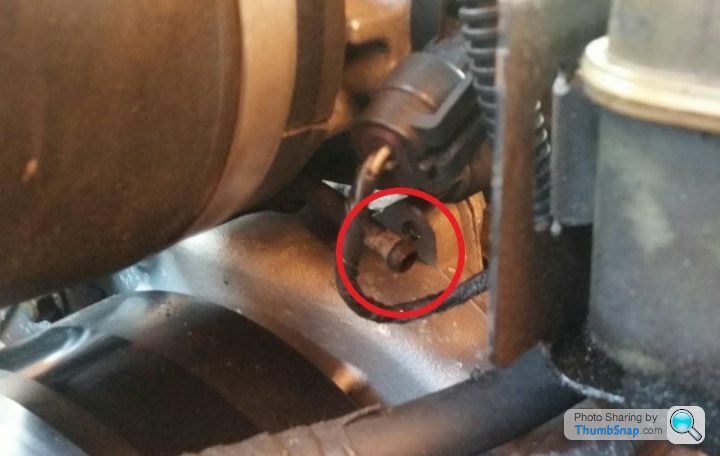
This seems to have been therefore bypassed resulting in the throttle body remaining cold when the engine coolant warms up. Well, as cold as can be expected in the engine bay of a 5.7 litre V8!
The radiator has the 2 small hoses connected. The right hand one goes to the expansion tank as is usual, but the left one goes straight into the thin metal pipe that runs between the cylinder heads:
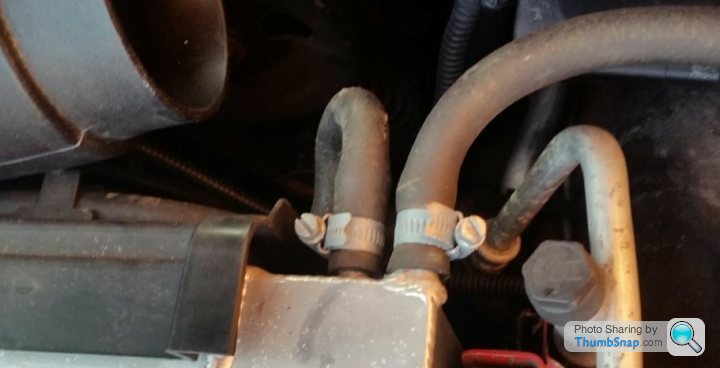
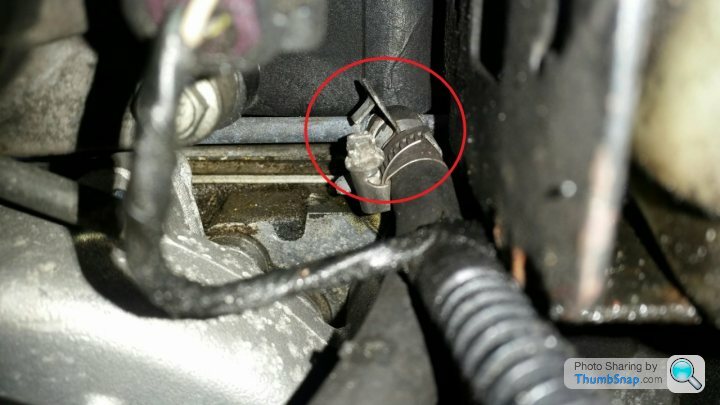


This seems to have been therefore bypassed resulting in the throttle body remaining cold when the engine coolant warms up. Well, as cold as can be expected in the engine bay of a 5.7 litre V8!
The radiator has the 2 small hoses connected. The right hand one goes to the expansion tank as is usual, but the left one goes straight into the thin metal pipe that runs between the cylinder heads:


The thin metal pipe is the coolant crossover pipe between the heads so makes sense for it to go to another coolant pipe.
I'm baffled as to why you'd send coolant through a throttle body? Does this actually happen? I have never heard of it, it's definitely not on the LS2 and I just don't see what benefit it would offer?
More than happy to be educated
I'm baffled as to why you'd send coolant through a throttle body? Does this actually happen? I have never heard of it, it's definitely not on the LS2 and I just don't see what benefit it would offer?
More than happy to be educated

SturdyHSV said:
The thin metal pipe is the coolant crossover pipe between the heads so makes sense for it to go to another coolant pipe.
I'm baffled as to why you'd send coolant through a throttle body? Does this actually happen? I have never heard of it, it's definitely not on the LS2 and I just don't see what benefit it would offer?
More than happy to be educated
The Z32 300zx (1990's car) used to do something similar, can't remember why, but it was always bypassed as the pipes got brittle and leaked.I'm baffled as to why you'd send coolant through a throttle body? Does this actually happen? I have never heard of it, it's definitely not on the LS2 and I just don't see what benefit it would offer?
More than happy to be educated

SturdyHSV said:
The thin metal pipe is the coolant crossover pipe between the heads so makes sense for it to go to another coolant pipe.
I'm baffled as to why you'd send coolant through a throttle body? Does this actually happen? I have never heard of it, it's definitely not on the LS2 and I just don't see what benefit it would offer?
More than happy to be educated
On MarvinTPA's post above, the photo of his engine shows the pipe in question connected to the coolant system. I'm baffled as to why you'd send coolant through a throttle body? Does this actually happen? I have never heard of it, it's definitely not on the LS2 and I just don't see what benefit it would offer?
More than happy to be educated


Lincsls1 said:
SturdyHSV said:
The thin metal pipe is the coolant crossover pipe between the heads so makes sense for it to go to another coolant pipe.
I'm baffled as to why you'd send coolant through a throttle body? Does this actually happen? I have never heard of it, it's definitely not on the LS2 and I just don't see what benefit it would offer?
More than happy to be educated
The Z32 300zx (1990's car) used to do something similar, can't remember why, but it was always bypassed as the pipes got brittle and leaked.I'm baffled as to why you'd send coolant through a throttle body? Does this actually happen? I have never heard of it, it's definitely not on the LS2 and I just don't see what benefit it would offer?
More than happy to be educated

"When liquids evaporate they will actively seek latent heat and is the case of a throttle body the heat will be drawn for the body itself. If the body gets too cool then any moisture in the incoming air will freeze - splutter splutter - engine stops.
This has been a problem since the first day the internal combustion engine was first built.
There are various methods to prevent this such as electrcial pre-heats, re-circulated air over the exhaust manifold and of course the engine coolant method. The engine coolant method being the most efficient and economical"
Gassing Station | HSV & Monaro | Top of Page | What's New | My Stuff




